The Rudolf-Diesel-Medaille is an award by the German Institute for Inventions in memory of Rudolf Diesel for inventions and the entrepreneurial and economical implications accounting to the laureate. Since 1953 the award has been presented yearly until 1969 and then irregularly every two or three years.
A Prussian Love Story is a 1938 German historical romance film directed by Paul Martin and starring Karl Günther, Hans Nielsen, and Willy Fritsch. The film depicts the love affair between William I and Elisa Radziwill. In the Third Reich the film was banned right after completion because the love affair of Joseph Goebbels and the actress Lída Baarová had become public. It was finally released in 1950 in West Germany.
Catherine the Great is a 1920 German silent historical film directed by Reinhold Schünzel and starring Lucie Höflich, Fritz Kortner, and Fritz Delius. The film was an epic portrayal of the life of Catherine the Great of Russia. 4,000 extras and 500 horses were used.
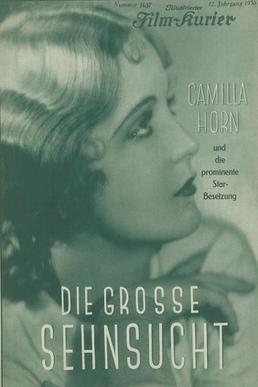
The Great Longing is a 1930 German comedy film directed by Steve Sekely in his directorial debut and starring Camilla Horn, Theodor Loos, and Harry Frank. It was shot at the EFA Studios in Berlin. The film's sets were designed by the art directors Hans Sohnle and Otto Erdmann. It was distributed by the German branch of Universal Pictures.

Uncle Bräsig is a 1936 German historical comedy film directed by Erich Waschneck and starring Otto Wernicke, Heinrich Schroth and Harry Hardt. It marked the film debut of the Swedish actress Kristina Söderbaum who went on to be a major star of Nazi cinema. Söderbaum won her part in a contest organised by UFA. It was based on the 1862 novel From My Farming Days by Fritz Reuter. The film was shot at the Grunewald Studios in Berlin with sets designed by the art director Robert A. Dietrich.

Othello is a 1922 German silent historical romantic drama film directed by Dimitri Buchowetzki, and starring Emil Jannings, Werner Krauss and Ica von Lenkeffy. It was based on William Shakespeare's play The Tragedy of Othello, the Moor of Venice, the first of six major film adaptations of the work. It was shot at the Johannisthal Studios in Berlin. The film's sets were designed by the art director Karl Machus.
Lola Montez, the King's Dancer is a 1922 German silent historical drama film directed by Willi Wolff and starring Ellen Richter, Arnold Korff, and Fritz Kampers. It portrays the life of Lola Montez. The film was produced by Richter's own production company, but was released by the dominant German distributor UFA.

The Higher Command is a 1935 German historical film directed by Gerhard Lamprecht and starring Lil Dagover, Karl Ludwig Diehl and Heli Finkenzeller. Produced and distributed by UFA, it was shot at the company's Babelsberg Studios in Potsdam. The film's sets were designed by the art directors Otto Erdmann and Hans Sohnle.

Above All Else in the World is a 1941 German drama film directed by Karl Ritter and starring Paul Hartmann, Hannes Stelzer and Fritz Kampers. The title refers to the second line of the German national anthem. It was made as a propaganda film designed to promote Nazi Germany's war aims in the Second World War.
Legion Condor is a 1939 German war film directed by Karl Ritter and starring Paul Hartmann, Albert Hehn and Fritz Kampers. The film portrays the German Condor Legion, which fought in the Spanish Civil War. Because of the German-Soviet Pact, the production was halted after 15 days of shooting, on 25 August 1939 to avoid offending the Soviets, who had supported the other side in Spain and were negatively portrayed in the film. Karl Ritter's diary entry that day stated that Hermann Göring had called the Ufa studio to tell him to abort the film.
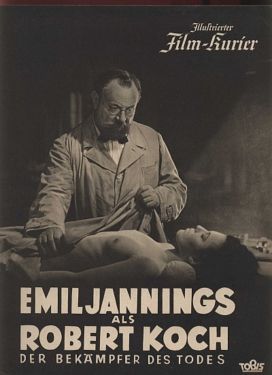
Robert Koch is a 1939 Nazi propaganda film directed by Hans Steinhoff and starring Emil Jannings, Werner Krauss and Viktoria von Ballasko. The film was a biopic of the German pioneering microbiologist Robert Koch (1843–1910). It was shot at the Johannisthal Studios in Berlin and premiered at the city's Ufa-Palast am Zoo. The film was made by the Tobis Film company, and was also distributed in the United States by the largest German studio UFA.

By a Silken Thread is a 1938 German drama film directed by Robert A. Stemmle and starring Willy Fritsch, Carl Kuhlmann and Käthe von Nagy. The film was intended to be an exposure of "crooked Jewish capitalists" in line with Nazi racial policy of the era. It was shot at the Babelsberg Studios of UFA in Potsdam. The film's sets were designed by the art director Otto Hunte.

Shadows Over St. Pauli is a 1938 German drama film directed by Fritz Kirchhoff and starring Marieluise Claudius, Gustav Knuth and Hellmuth Bergmann. It was filmed and shot in Hamburg, and the title refers to the St. Pauli district of the city.
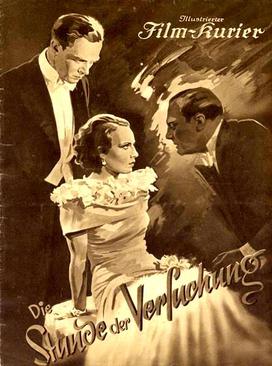
The Hour of Temptation is a 1936 German mystery film directed by Paul Wegener and starring Gustav Fröhlich, Lída Baarová and Harald Paulsen.
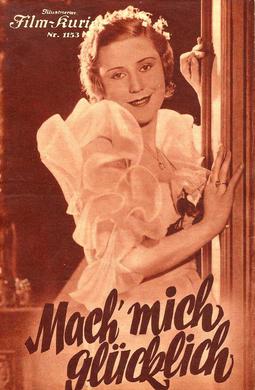
Make Me Happy is a 1935 German musical comedy film directed by Arthur Robison and starring Julia Serda, Albert Lieven and Richard Romanowsky. It was made by Germany's largest film company UFA. A separate French-language version Les époux célibataires was released, also directed by Robison. It was shot at the Babelsberg Studios in Berlin. The film's sets were designed by the art director Otto Hunte and Willy Schiller.
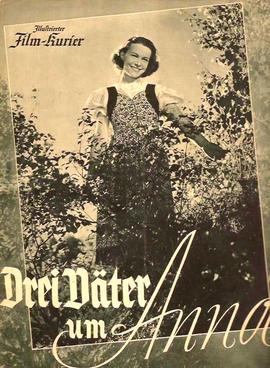
Three Fathers for Anna is a 1939 German comedy film directed by Carl Boese and starring Ilse Werner, Hans Stüwe and Theodor Danegger. It was made by the German company UFA at the firm's Babelsberg Studios in Potsdam, with some location shooting taking place around Passau in Bavaria. The film's sets were designed by the art director Herbert Frohberg.
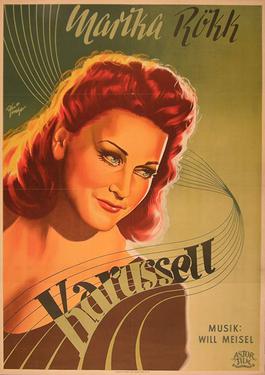
Carousel is a 1937 German musical film directed by Alwin Elling and starring Marika Rökk, Georg Alexander, and Paul Henckels. It was shot at the Babelsberg Studios of UFA in Potsdam. The film's sets were designed by the art directors Artur Günther and Karl Vollbrecht.
Goetz von Berlichingen of the Iron Hand is a 1925 German silent historical adventure film directed by Hubert Moest and starring Eugen Klöpfer, Friedrich Kühne and Paul Hartmann. It is an adaptation of the 1773 play Götz von Berlichingen by Johann Wolfgang von Goethe.

Under Blazing Skies or Under Blazing Heavens is a 1936 German adventure film directed by Gustav Ucicky and starring Hans Albers, Lotte Lang and Aribert Wäscher. It was shot at the Babelsberg Studios in Berlin and on location on the Aegean Sea coast of Greece. The film's sets were designed by the art directors Robert Herlth and Walter Röhrig. It was produced and distributed by UFA, Germany's largest film company. The film was popular enough to be given a second release in West Germany in 1950.













